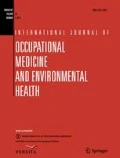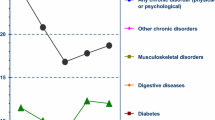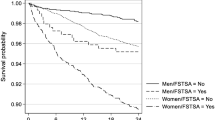Abstract
Objectives
Data on the prevalence of chronic diseases and their relationship with sickness absence in the Italian public employees are rather scarce. Therefore, in the first place, we assessed the distribution of chronic diseases in the employees of the University of Ferrara. As a next step, we investigated the possible associations between each chronic disease and cumulative days of all-cause sickness absence, and finally we investigated the odds ratio of each single chronic disease on sickness absence.
Material and Methods
A total of 514 employees, 269 sick-listed and 245 not sick-listed in 2012, were studied. Demographical/clinical characteristics and chronic diseases were obtained from all study participants during medical surveillance procedures. Sickness absence days and job seniority data were obtained from the administrative office.
Results
Gastrointestinal and psychiatric diseases were the most reported in the sick-listed sample (p = 0.01 and p = 0.02, respectively, compared to the not sick-listed). In the interquantile regression analysis, the sickness absence days were as?sociated with psychiatric diseases (β = 65.1, 95% CI: 13.2-117.1, p = 0.01) and with the presence of 2 or more chronic diseases (β = 23.3, 95% CI: 4.5–42, p = 0.02). Furthermore, the logistic regression analysis showed that the odds of sickness absence were increased 2 fold by psychiatric diseases (OR = 2.2, 95% CI: 1.01–4.93, p = 0.04), and gastrointestinal diseases (OR = 1.9, 95% CI: 1.07–3.42, p = 0.02) and, to a lesser extent, by high body mass index (OR = 1.05, 95% CI: 1–1.11, p = 0.03). Conversely, female gender reduced by half the odds of sickness absence (OR = 0.5, 95% CI: 0.3–0.8, p = 0.04).
Conclusions
This study highlights the relevant association between chronic diseases and sickness absence in Italian public employees. Our findings indicate the importance of considering the health status when designing preventive interventions aimed at decreasing sickness absences in this population.
Similar content being viewed by others
References
Kivimaki M, Head J, Ferrie JE, Shipley MJ, Vahtera J, Marmot MG. Sickness absence as a global measure of health: Evidence from mortality in the Whitehall II prospective cohort study. BMJ. 2003;327(7411):364, http://dx.doi.org/10.1136/bmj.327.7411.364.
Kivimaki M, Head J, Ferrie JE, Singh-Manoux A, Westerlund H, Vahtera J, et al. Sickness absence as a prognostic marker for common chronic conditions: Analysis of mortality in the GAZEL study. Occup Environ Med. 2008;65(12): 820–826, http://dx.doi.org/10.1136/oem.2007.038398.
Vahtera J, Westerlund H, Ferrie JE, Head J, Melchior M, Singh-Manoux A, et al. All-cause and diagnosis specific sickness absence as a predictor of sustained suboptimal health: A 14-year follow-up in the GAZEL cohort. J Epidemiol Community Health. 2010;64(4):311–317, http://dx.doi.org/10.1136/jech.2008.083923.
Wallman T, Wedel H, Palmer E, Rosengren A, Johansson S, Eriksson H, et al. Sick-leave track record and other potential predictors of a disability pension. A population based study of 8,218 men and women followed for 16 years. BMC Publ Health. 2009;9:104, http://dx.doi.org/10.1186/1471-2458-9-104.
Online published data on employment rate stratified by age [Internet]. EUROSTAT 2012 [cited 2013 Jun 1]. Available from: http://epp.eurostat.ec.europa.eu/portal/page/portal/eurostat/home.
Pomerleau J, Knai C, Nolte E. The burden of chronic disease in Europe. In: Nolte E, McKee M, editors. Caring for people with chronic conditions: A health system perspective. Maidenhead: McGraw-Hill; 2008. p. 15–42.
Busse R, Blümel M, Scheller-Kreinsen D, Zentne A. Tackling chronic disease in Europe: strategies, interventions and challenges. 1th ed. London: European Observatory on Health Systems and Policies; 2010.
Online published data on chronic diseases prevalence in Italy [Internet]. Italian National Institute of Statistics, ISTAT 2012 [cited 2013 Jun 15]. Available from: http://dati.istat.it/Index.aspx.
Bergh H, Baigi A, Mansson J, Mattsson B, Marklund B. Predictive factors for longterm sick leave and disability pension among frequent and normal attenders in primary health care over 5 years. Public Health. 2007;121(1):25–33, http://dx.doi.org/10.1016/j.puhe.2006.08.018.
Hemingway H, Vahtera J, Virtanen M, Pentti J, Kivimaki M. Outcome of stable angina in a working population: The burden of sickness absence. Eur J Cardiovasc Prev Rehabil. 2007;14(3):373–379, http://dx.doi.org/10.1097/01.hjr.0000230106.01396.a2.
Kivimaki M, Leino-Arjas P, Kaila-Kangas L, Virtanen M, Elovainio M, Puttonen S, et al. Increased absence due to sickness among employees with fibromyalgia. Ann Rheum Dis. 2007;66(1):65–69, http://dx.doi.org/10.1136/ard.2006.053819.
Erickson SR, Kirking DM. A cross-sectional analysis of work-related outcomes in adults with asthma. Ann Allergy Asthma Immunol. 2002;88(3):292–300, http://dx.doi.org/10.1016/S1081-1206(10)62011-X.
De Paola M, Scoppa V, Pupo V. Absenteeism in the Italian public sector: The effects of changes in sick leave compensation. Working Paper n. 16. Arcavacata di Rende: Dipartimento di Economia e Statistica, Università della Calabria; 2009.
Italian Ministry of Economy. Survey on working labor force. Roma: Ministero dell’Economia e delle Finanze; 2012.
D’Errico A, Costa G. Socio-demographic and work-related risk factors for medium- and long-term sickness absence among Italian workers. Eur J Public Health. 2012;22(5): 683–688, http://dx.doi.org/10.1093/eurpub/ckr140.
Del Boca A, Parisi ML. Why does the private sector react like the public to law 133? A microeconometric analysis of sickness absence in Italy. Working Papers n. 1008. Brescia: Brescia University; 2010.
Scoppa V. Worker absenteeism and incentives: Evidence from Italy. Manag Decis Econ. 2010;31:503–515, http://dx.doi.org/10.1002/mde.1504.
Lundl T, Christensen KB, Vaez M, Labriola M, Josephson M, Villadsen E, et al. Differences in sickness absence in Sweden and Denmark: The cross national HAKNAK study. Eur J Public Health. 2008;19(3):343–349, http://dx.doi.org/10.1093/eurpub/ckn128.
Eriksson H, von Celsing AS, Wahlström R, Janson L, Zander V, Wallman T. Sickness absence and self-reported health a population-based study of 43,600 individuals in central Sweden. BMC Public Health. 2008;8:426, http://dx.doi.org/10.1186/1471-2458-8-426.
Hansson T, Jensen I. Swedish Council on technology assessment in health care (SBU). Chapter 6. Sickness absence due to back and neck disorders. Scand J Public Health Suppl. 2004;63:109–151, http://dx.doi.org/10.1080/14034950410021862.
Coggon D, Ntani G, Vargas-Prada S, Martinez JM, Serra C, Benavides FG, et al. International variation in absence from work attributed to musculoskeletal illness: Findings from the CUPID study. Occup Environ Med. 2013;70(8):575–584, http://dx.doi.org/10.1136/oemed-2012-101316.
Kuijer W, Groothoff JW, Brouwer S, Geertzen JH, Dijkstra PU. Prediction of sickness absence in patients with chronic low back pain: A systematic review. J Occup Rehabil. 2006;16(3):439–467, http://dx.doi.org/10.1007/s10926-006-9021-8.
Arends I, van der Klink JJ, van Rhenen W, de Boer MR, Bültmann U. Predictors of recurrent sickness absence among workers having returned to work after sickness absence due to common mental disorders. Scand J Work Environ Health. 2014;40(2):195–202, http://dx.doi.org/10.5271/sjweh.3384.
Pedersen J, Bjorner JB, Burr H, Christensen KB. Transitions between sickness absence, work, unemployment, and disability in Denmark 2004–2008. Scand J Work Environ Health. 2012;38(6):516–526, http://dx.doi.org/10.5271/sjweh.3293.
Ármannsdóttir B, Mårdby AC, Haukenes I, Hensing G. Cumulative incidence of sickness absence and disease burden among the newly sick-listed, a cross-sectional population-based study. BMC Public Health. 2013;13:329–339, http://dx.doi.org/10.1186/1471-2458-13-329.
Topics on chronic diseases. World Health Organization 2008 [cited 2013 Jun 1]. Available from: http://www.who.int/topics/chronic_diseases/en/.
Carneiro IG, Rasmussen CDN, Jørgensen MB, Flyvholm M-A, Olesen K, Madeleine P, et al. The association between health and sickness absence among Danish and non-Western immigrant cleaners in Denmark. Int Arch Occup Environ Health. 2013;86(4):397–405, http://dx.doi.org/10.1007/s00420-012-0773-5.
Kronborg CN, Hallas J, Jacobsen IA. Prevalence, awareness, and control of arterial hypertension in Denmark. J Am Soc Hypertens. 2009;3(1):19–24, http://dx.doi.org/10.1016/j.jash.2008.08.001.
Razminia M, Trivedi A, Molnar J, Elbzour M, Guerrero M, Salem Y, et al. Validation of a new formula for mean arterial pressure calculation: The new formula is superior to the standard formula. Catheter Cardiovasc Interv. 2004;63(4): 419–425, http://dx.doi.org/10.1002/ccd.20217.
Koenker R. Quantile Regression. New York: Cambridge University Press; 2005, http://dx.doi.org/10.1017/CBO9780511754098.
Soegaard HJ. Undetected common mental disorders in long-term sickness absence. Int J Family Med. 2012;2012:1–9, http://dx.doi.org/10.1155/2012/474989.
Jansson C, Wiberg M, Alexanderson K. Sickness absence due to gastroesophageal reflux diagnoses: A nationwide Swedish population-based study. Scand J Gastroenterol. 2013;48(1): 17–26, http://dx.doi.org/10.3109/00365521.2012.737359.
Roskes K, Donders CG, van der Gulden JW. Health-related and work-related aspects associated with sick leave: A comparison of chronically ill and non-chronically ill workers. Int Arch Occup Environ Health. 2005;78(4):270–278, http://dx.doi.org/10.1007/s00420-004-0596-0.
Knudsen AK, Harvey SB, Mykletun A, øverland S. Common mental disorders and long-term sickness absence in a general working population. The Hordaland Health Study. Acta Psychiatr Scand. 2013;127(4):287–297, http://dx.doi.org/10.1111/j.1600-0447.2012.01902.x.
Overland S, Knapstad M, Wilhelmsen I, Mykletun A, Glozier N. Do gastrointestinal complaints increase the risk for subsequent medically certified long-term sickness absence? The HUSK study. BMC Gastroenterol. 2011;11:88–98, http://dx.doi.org/10.1186/1471-230X-11-88.
Stansfeld SA, Fuhrer R, Head J. Impact of common mental disorders on sickness absence in an occupational cohort study. Occup Environ Med. 2011;68(6):408–413, http://dx.doi.org/10.1136/oem.2010.056994.
Guh DP, Zhang W, Bansback N, Amarsi Z, Birmingham CL, Anis AH, et al. The incidence of co-morbidities related to obesity and overweight: A systematic review and meta-analysis. BMC Public Health. 2009;9: 88–108, http://dx.doi.org/10.1186/1471-2458-9-88.
Maachi M, Piéroni L, Bruckert E, Jardel C, Fellahi S, Hainque B, et al. Systemic low-grade inflammation is related to both circulating and adipose tissue TNFalpha, leptin and IL-6 levels in obese women. Int J Obes Relat Metab Disord. 2004;28(8):993–997, http://dx.doi.org/10.1038/sj.ijo.0802718.
Korpela K, Roos E, Lallukka T, Rahkonen O, Lahelma E, Laaksonen M. Different measures of body weight as predictors of sickness absence. Scand J Public Health. 2013; 41(1):25–31, http://dx.doi.org/10.1177/1403494812468965.
Harvey SB, Glozier N, Carlton O, Mykletun A, Henderson M, Hotopf M, et al. Obesity and sickness absence: results from the CHAP study. Occup Med. 2010;60(5): 362–368, http://dx.doi.org/10.1093/occmed/kqq031.
Laaksonen M, Mastekaasa A, Martikainen P, Rahkonen O, Piha K, Lahelma E. Gender differences in sickness absence, the contribution of occupation and workplace. Scand J Work Environ Health. 2010;36(5):394–403, http://dx.doi.org/10.5271/sjweh.2909.
Bekker MH, Rutte CG, van Rijswijk K. Sickness absence: A gender-focused review. Psychol Health Med. 2009;14(4): 405–418, http://dx.doi.org/10.1080/13548500903012830.
Duijts SF, Kant I, Swaen GM, van den Brandt PA, Zeegers MP. A meta-analysis of observational studies identifies predictors of sickness absence. J Clin Epidemiol. 2007;60(11): 1105–1115, http://dx.doi.org/10.1016/j.jclinepi.2007.04.008.
Lerner DJ, Amick BC 3rd, Malspeis S, Rogers WH. A national survey of health-related work limitations among employed persons in the United States. Disabil Rehabil. 2000;22(5): 225–232, http://dx.doi.org/10.1080/096382800296791.
Munir F, Yarker J, Haslam C, Long H, Leka S, Griffiths A, et al. Work factors related to psychological and health-related distress among employees with chronic illnesses. J Occup Rehabil. 2007;17(2):259–277, http://dx.doi.org/10.1007/s10926-007-9074-3.
Westhoff G, Dörner T, Zink A. Fatigue and depression predict physician visits and work disability in women with primary Sjögren’s syndrome: Results from a cohort study. Rheumatology (Oxford). 2012;51(2):262–269, http://dx.doi.org/10.1093/rheumatology/ker208.
Ferrie JE, Kivimäki M, Westerlund H, Head J, Melchior M, Singh-Manoux A, et al. Differences in the association between sickness absence and long-term sub-optimal health by occupational position: A 14-year follow-up in the GAZEL cohort. Occup Environ Med. 2011;68(10): 729–733, http://dx.doi.org/10.1136/oem.2010.060210.
Author information
Authors and Affiliations
Corresponding author
About this article
Cite this article
Casimirri, E., Vaccari, A., Schito, M. et al. Chronic diseases are strongly associated with sickness absences in a sample of Italian public employees. IJOMEH 27, 343–354 (2014). https://doi.org/10.2478/s13382-014-0256-x
Received:
Accepted:
Published:
Issue Date:
DOI: https://doi.org/10.2478/s13382-014-0256-x




